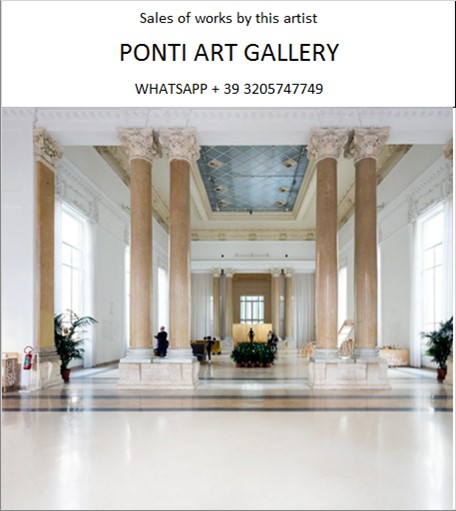Ponti Art Gallery is interested in buying and selling works
of art by this artist.

Mario Deluigi Biography
Mario Deluigi, born in Treviso in 1901 and passing away in Venice in 1978, was an Italian painter whose artistic journey and contributions have left a significant mark on the 20th-century art scene. His education at Venice's "Accademia di Belle Arti" under the tutelage of Ettore Tito and Virgilio Guidi laid the foundational stones of his artistic career, providing him with the technical skills and the creative impetus to explore and express his unique vision through painting.
Deluigi's work is characterized by his innovative use of the grattage technique, a method that involves scratching the surface of a painting to reveal lower layers of color or to create a distinct texture. This technique became a hallmark of his style, allowing him to experiment with and express abstract concepts in a visually compelling manner. His exploration of texture and form through grattage positioned him as a significant figure in the abstract art movement, distinguishing his work from that of his contemporaries.
Throughout his career, Deluigi exhibited his work extensively, both in Italy and internationally, gaining recognition and acclaim for his contributions to the art world. His artworks have been featured in key galleries and museums, highlighting his importance as an artist and the enduring appeal of his work.
One of the most fascinating aspects of Deluigi's artistic journey was his last studio, occupied from 1971 until his death in 1978, located in Palazzo Fortuny. This space, once the headquarters of the Università Internazionale dell'Arte, became the crucible for his final creations. The studio, as described by those who had the opportunity to visit before it was vacated, was a vivid reflection of Deluigi's artistic and intellectual preoccupations. In the entrance hall, where he preferred to paint, stood his last and unfinished work on an easel, surrounded by the tools of his trade and reproductions of works by Vermeer hung upside down. Deluigi's interest in Vermeer was not rooted in the figurative or narrative aspects of the Dutch painter's work but in his experiments with light. By inverting Vermeer's images, Deluigi sought to focus on their luminosity, creating a bridge between the 17th-century artist's exploration of light and his own abstract endeavors.
The second room of the studio revealed another facet of Deluigi's artistic process, showcasing the tools he used to scratch and scar his works in progress, such as razor blades, paper cutters, and scalpels. This space underscored his commitment to the physical act of creation, where the manipulation of materials was integral to the realization of his artistic vision.
The third room served a different purpose, acting as a space for writing, and for receiving friends, students, and collectors. It was here that the personal aspects of Deluigi's life intersected with his professional world, offering a glimpse into the relationships and influences that shaped him as an artist and individual.
Deluigi's legacy is not only preserved in the artworks he left behind but also in the memories of those who knew him and the spaces he inhabited. His studio in Palazzo Fortuny, with its layers of personal and artistic history, offers a poignant insight into the life of an artist who was deeply engaged with the visual and intellectual challenges of his time. Through his innovative techniques, his exploration of light and form, and his commitment to abstraction, Mario Deluigi made a lasting contribution to the art world, securing his place as a significant figure in the history of 20th-century art.
Mario Deluigi Quotes and Sales
of Works
Ponti Art Gallery selects and deals with paintings by the
artist. Upon request, we provide free estimates and
evaluations, communicate prices, quotations, and current
market values.
If you are interested in BUYING or SELLING works by the
artist, contact us immediately.
If you wish to sell or receive an evaluation of the
works:
Send us a frontal photo of the painting, one of the back,
and one of the signature. Also, indicate the dimensions of
the work. Inform us about the purchase origin of the work
and any kind of available documentation (purchase
receipts, certificates of authenticity, publications). One
of our operators will respond to you on the same day. We
guarantee maximum confidentiality and extreme
professionalism.
If you wish to purchase works by the painter: Contact us
and let us know your request. We will inform you about the
available works. We also offer the possibility to
subscribe to our NEWSLETTER, through which you will be
informed at the beginning of each month about the latest
acquisitions of the art gallery.
You can send us pictures of the work:
